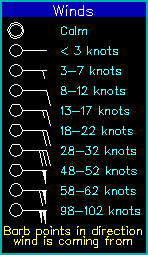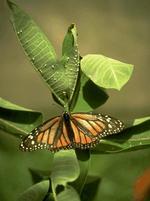Monarch Home Page
Challenge Questions

Today's News

Spring's Journey North

Report Your Sightings

Teacher's Manual

Search Journey North
return to:

Monarch Butterfly Update: March 31, 1998
Today's Report Includes:
- Latest Migration News and Data
- Field Notes From Texas
- Milkweed and Migration
- Report the FIRST Monarch Eggs
- Food to Fuel the Migration?
- Prepare to Make Good Field Observations
- Discussion of Challenge Question #7
- Challenge Question #8
Latest Migration News and Data
The migration has now spread across Texas and into Louisiana, Oklahoma, Mississippi and Arkansas. In the past week, 27 monarchs have been reported from the following locations:
- Link to Today's Migration Data*
* Special thanks to Monarch Watch and Texas Monarch Watch for contributing data for this study.
Field Notes From Texas
"We are having very strong south winds, with gusts up to 35 mph," Bill Calvert reported from Texas. "These winds are undoubtedly driving the monarchs north!"
"Very surprisingly, the highest numbers have been reported from the northern parts of the state. Mickey Keener saw over 100 near Longview, Texas, not too far from Louisiana and Arkansas. That same day Dale Clark reported over 30 from the Dallas area. Both mentioned that high south winds have accompanied the monarchs' northward trek. Both have planted milkweeds abounding in their
gardens. It is likely that the cultivated milkweeds played a role in concentrating the monarchs.
 |
 |
"These north Texas sightings supports our suspicion that the monarchs shoot up the prairie region of the state. These strong south winds seem to have pushed them. The big question is, can they find milkweed that far north?"
Milkweed and Migration
|
Monarch Watch Field Guide to
Milkweed |
How many days before the first monarch arrives does milkweed emerge from the soil?
Record the height of milkweed it grows this spring, and include this information when you report your first
monarch.
"Yesterday, I spotted my first monarch--and today I spotted my first monarch eggs! In my newly planted butterfly garden, I counted 17 monarch eggs on my 2 milkweed plants (tropical milkweed).
Terra Almogabar
Cedar Creek, TX (SE of Austin)
hormiga@flash.net
|
Photo by Jim Gilbert |
What's available for adult monarchs to eat as they travel? Keep your eyes open for the first flowers to bloom in your area. Are any flowers available now? When you report your FIRST monarch, include these observations in the comments section. (Remember to include flowering trees--even apple or cherry blossoms--and inconspicuous flowers such as clover and dandelions.)
Prepare to Make Good Field Observations
Please print the Journey North Monarch Migration Checklist and take it with you in the field. Take notes on all of the following topics. When you report your monarch sightings to Journey North, please include as much of this information as possible in the "Comments" section of your report:
 Discussion of Challenge Question #7
Discussion of Challenge Question #7Last week, we reported unexpected sightings of monarchs along the Florida Gulf Coast--at the same time the migration from Mexico had just reached Texas. Challenge Question #7 asked: "What questions do you have for the observer on the Florida Gulf Coast? Where do you think the monarchs sighted there on 3/15/98 were coming from?"
Mrs. Jensen's students on the Minot Air Force Base in North Dakota would like to know:
- What condition were the wings and the butterflies in when you saw them?
- Does this have anything to do with El Nino?
Grade 7 students in Butler , NJ checked their map and drew this conclusion: "The butterflies went from
Mexico into Texas, from Texas to Louisiana, and then over the Gulf of Mexico to Florida." (cyberkids@nac.net)
|
Dr. Gibo and his monarch flight simulator |
- Dr. David Gibo University of Toronto
- Dr. Chip Taylor Monarch Watch
- Don Davis, Toronto, Ontario
- Dr. Bill Calvert, Texas Monarch Watch
Challenge Question #8
Many migratory songbirds travel at night, when the weather is calm, the predators are sleeping, and they have a clear view of the stars to guide them.
Challenge Question #8
"Why do you think it's unlikely that monarch butterflies migrate at night? List as many reasons as you can."
How to Respond to Today's Challenge Question
1. Address an e-mail message to: jn-challenge-monarch@learner.org
2. In the Subject Line of your message write: Challenge Question # 8
3. In the body of the message, answer the question above.
The Next Monarch Butterfly Migration Update Will be Posted on April 7, 1998.
Copyright 1998 Journey North. All Rights Reserved.







